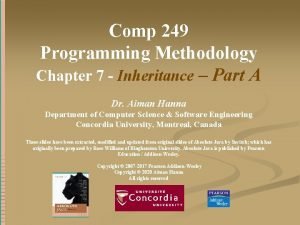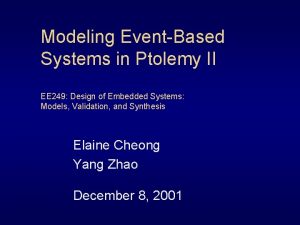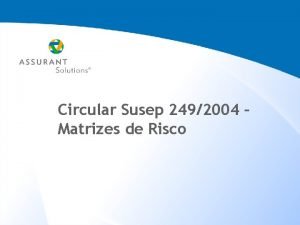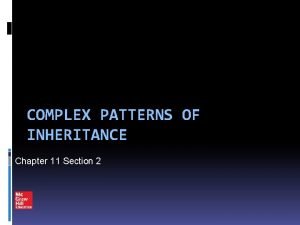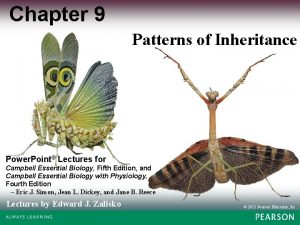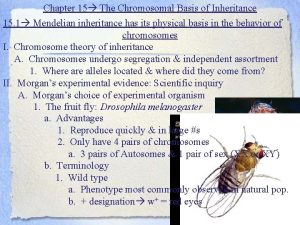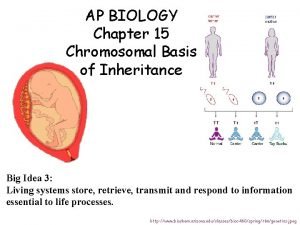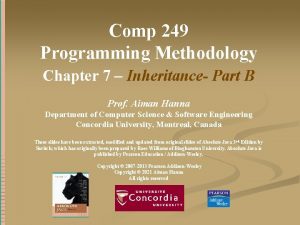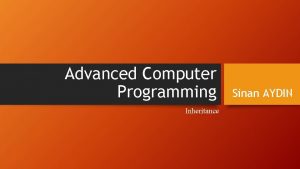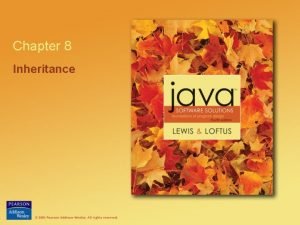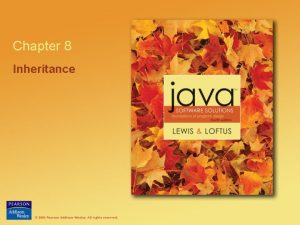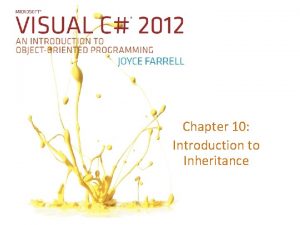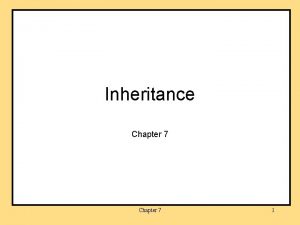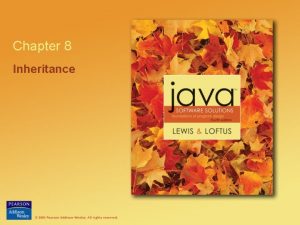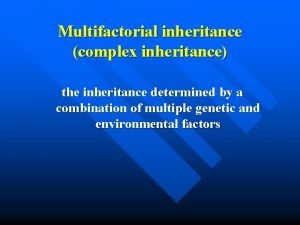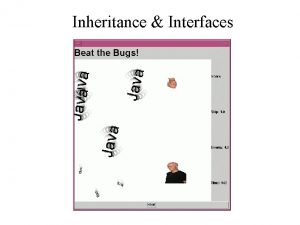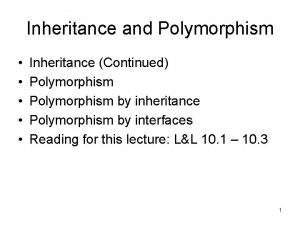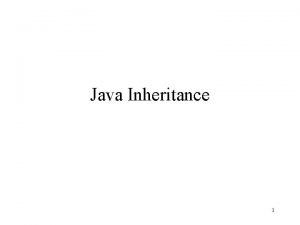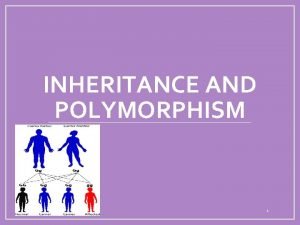Comp 249 Programming Methodology Chapter 7 Inheritance Part





















- Slides: 21

Comp 249 Programming Methodology Chapter 7 - Inheritance – Part A Dr. Aiman Hanna Department of Computer Science & Software Engineering Concordia University, Montreal, Canada These slides have been extracted, modified and updated from original slides of Absolute Java by Savitch; which has originally been prepared by Rose Williams of Binghamton University. Absolute Java is published by Pearson Education / Addison-Wesley. Copyright © 2007 -2017 Pearson Addison-Wesley Copyright © 2020 Aiman Hanna All rights reserved

Introduction to Inheritance n Inheritance is one of the main techniques of object-oriented programming (OOP) n Using this technique, further classes can be created from existing ones; those classes are said to inherit the methods and instance variables of the class they inherited n n n The new class is called a derived class The original class is called the base class Advantage: Reusing existing code 7 -2

Derived Classes n When designing certain classes, there is often a natural hierarchy for grouping them n n n For instance, for the employees of a company, there are hourly employees and salaried employees Hourly employees can be divided into full time and part time workers Salaried employees can be divided into those on technical staff, and those on the executive staff 7 -3

A Class Hierarchy 7 -4

Derived Classes n Since an hourly employee is an employee, it is defined as a derived class of the class Employee n n n A derived class is defined by adding instance variables and methods to an existing class The existing class that the derived class is built upon is called the base class The phrase extends Base. Class must be added to the derived class definition: public class Hourly. Employee extends Employee n See Inherit 1. java 7 -5

Derived Classes n Derived classes (also referred to as subclasses) inherit all instance variables and methods of the base class (also referred to as superclass). n Any object of a derived class can invoke one of these parent methods, just like any of its own methods n The derived class can add more instance variables, static variables, and/or methods n See Inherit 2. java 7 -6

Parent and Child Classes n A base class is often called the parent class n n A derived class is then called a child class These relationships are often extended such that a class that is a parent of a parent. . . of another class is called an ancestor class n If class A is an ancestor of class B, then class B can be called a descendent of class A 7 -7

Overriding a Method Definition n Although a derived class inherits methods from the base class, it can change or override an inherited method if necessary n In order to override a method definition, a new definition of the method is simply placed in the class definition, just like any other method that is added to the derived class n See Inherit 3. java 7 -8

Changing the Return Type of an Overridden Method n n n Ordinarily, the type returned may not be changed when overriding a method However, if it is a class type, then the returned type may be changed to that of any descendent class of the returned type This is known as a covariant return type n Covariant return types are new in Java 5. 0; they are not allowed in earlier versions of Java 7 -9

Covariant Return Type n Given the following base class: public class Base. Class {. . . public Employee get. Someone(int some. Key). . . n The following is allowed in Java 5. 0: public class Derived. Class extends Base. Class {. . . public Hourly. Employee get. Someone(int some. Key). . . 7 -10

Changing the Access Permission of an Overridden Method The access permission of an overridden method can be changed from private in the base class to public (or some other more permissive access) in the derived class n However, the access permission of an overridden method can not be changed from public in the base class to a more restricted access permission in the derived class n 7 -11

Changing the Access Permission of an Overridden Method n Given the following method header in a base case: private void do. Something() n The following method header is valid in a derived class: public void do. Something() n n However, the opposite is not valid Given the following method header in a base case: public void do. Something() n The following method header is not valid in a derived class: 7 -12

Pitfall: Overriding Versus Overloading n Do not confuse overriding with overloading n n n When a method is overridden, the new method definition given in the derived class has the exact same number and types of parameters as in the base class When a method in a derived class has a different signature from the method in the base class, that is overloading Note that when the derived class overloads the original method, it still inherits the original method from the base class as well 7 -13

The final Modifier If the modifier final is placed before the definition of a method, then that method may not be overridden in a derived class n It the modifier final is placed before the definition of a class, then that class may not be used as a base class to derive other classes n n See Inherit 4. java 7 -14

The super Constructor n A derived class uses a constructor from the base class to initialize all the data inherited from the base class n In order to invoke a constructor from the base class, it uses a special syntax: public derived. Class(int p 1, int p 2, double p 3) { super(p 1, p 2); instance. Variable = p 3; } n In the above example, super(p 1, p 2); is a call to the base class constructor n See Inherit 5. java 7 -15

The super Constructor n n n A call to the base class constructor can never use the name of the base class, but uses the keyword super instead A call to super must always be the first action taken in a constructor definition Notice that if super is not used, then a call to the default constructor of the base class is automatically issued Consequently, a compilation error would occur if the base class has no default constructor See Inherit 6. java 7 -16

The this Constructor n Within the definition of a constructor for a class, this can be used as a name for invoking another constructor of the same class n The same restrictions on how to use a call to super apply to the this constructor n If it is necessary to include a call to both super and this, the call using this must be made first, and then the constructor that is called must call super as its first action n See Inherit 8. java 7 -17

The this Constructor n Often, a no-argument constructor uses this to invoke an explicit-value constructor n No-argument constructor (invokes explicit-value constructor using this and default arguments): public Class. Name() { this(argument 1, argument 2); } n Explicit-value constructor (receives default values): public Class. Name(type 1 param 1, type 2 param 2) {. . . } 7 -18

The this Constructor Example: public Hourly. Employee() { this("No name", new Date(), 0, 0); } n The above constructor will cause the constructor with the following heading to be invoked: public Hourly. Employee(String the. Name, Date the. Date, double the. Wage. Rate, double the. Hours) 7 -19

Tip: An Object of a Derived Class Has More than One Type n n n An object of a derived class has the type of the derived class, and it also has the type of the base class More generally, an object of a derived class has the type of every one of its ancestor classes n Therefore, an object of a derived class can be assigned to a variable of any ancestor type An object of a derived class can be plugged in as a parameter in place of any of its ancestor classes In fact, a derived class object can be used anyplace that an object of any of its ancestor types can be used Note, however, that this relationship does not go the other way n An ancestor type can never be used in place of one of its derived types See Inherit 9. java 7 -20

Pitfall: The Terms "Subclass" and "Superclass" n The terms subclass and superclass are sometimes mistakenly reversed n n A superclass or base class is more general and inclusive, but less complex A subclass or derived class is more specialized, less inclusive, and more complex n As more instance variables and methods are added, the number of objects that can satisfy the class definition becomes more restricted 7 -21
 Comp 249
Comp 249 Dm 249
Dm 249 Artigo 249 cc
Artigo 249 cc Kew.67 pin.1 84
Kew.67 pin.1 84 How to convert y=a(x-h)^2+k into y=ax2+bx+c
How to convert y=a(x-h)^2+k into y=ax2+bx+c V c c
V c c Ee 249
Ee 249 Risco circular
Risco circular Perbedaan linear programming dan integer programming
Perbedaan linear programming dan integer programming Greedy algorithm vs dynamic programming
Greedy algorithm vs dynamic programming Windows 10 system programming, part 1
Windows 10 system programming, part 1 Linear vs integer programming
Linear vs integer programming Definisi linear
Definisi linear Complex patterns of inheritance
Complex patterns of inheritance Chapter 16 the molecular basis of inheritance
Chapter 16 the molecular basis of inheritance Chromosomal theory of inheritance
Chromosomal theory of inheritance Chapter 11 complex inheritance and human heredity test
Chapter 11 complex inheritance and human heredity test A gene locus is
A gene locus is Chapter 16: the molecular basis of inheritance
Chapter 16: the molecular basis of inheritance 15/16
15/16 The chromosomal basis of inheritance chapter 15
The chromosomal basis of inheritance chapter 15 Ap biology chapter 15
Ap biology chapter 15
